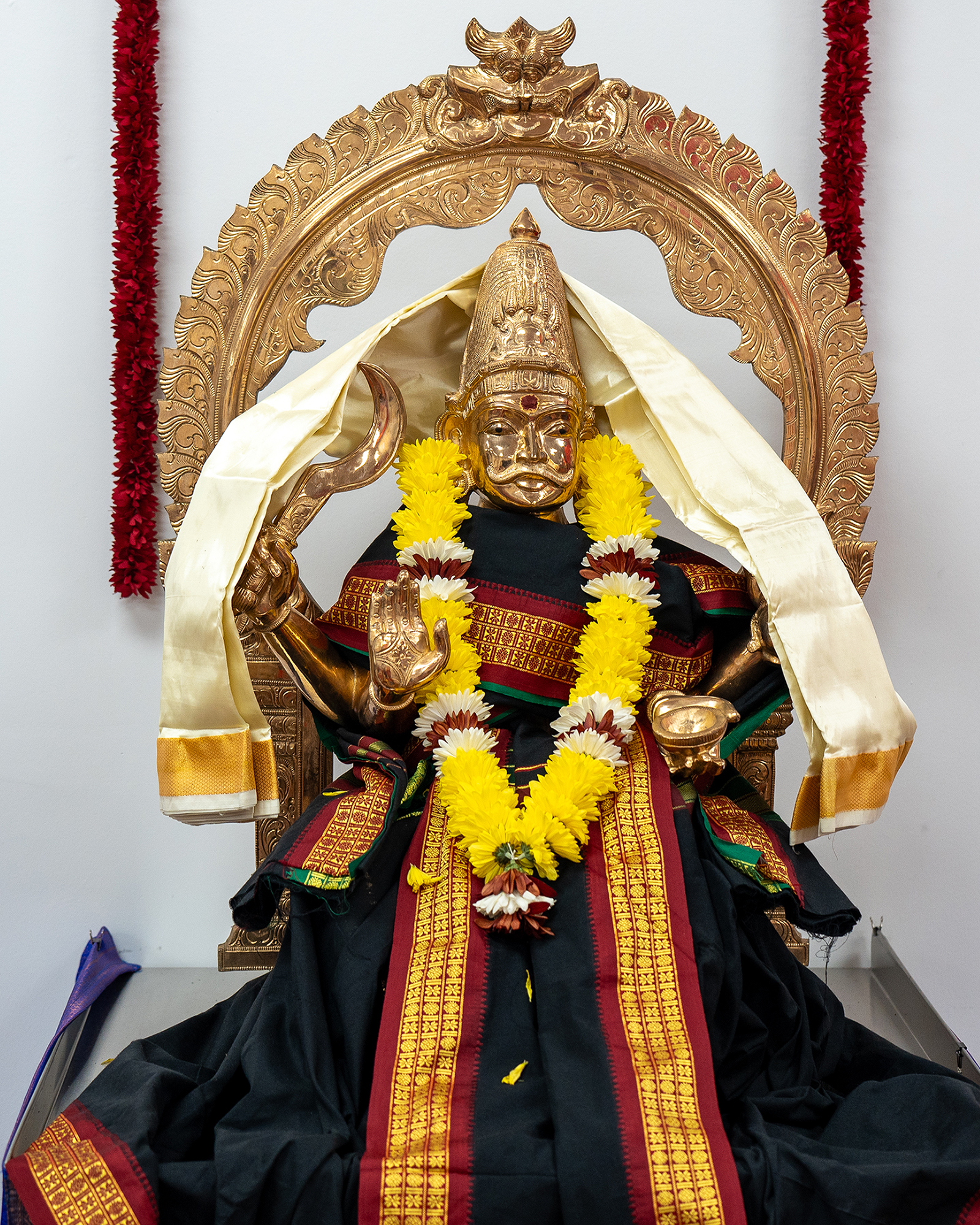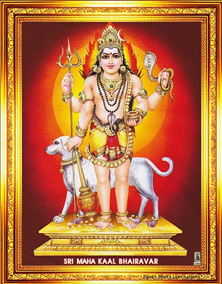
Kalabhirava

Who is Kala Bhairava
Kaala Bhairava is the eternal and ancient lord of the universe. He guides us in the path of Dharma. Kaala means time as well as the color black. He is the keeper of time (Kaala swarupam). Bhairava originates from the word bhīru, which means “fearsome”. Bhairava means “terribly fearsome form”. He is the one who destroys fear or one who is beyond fear. He protects his devotees from dreadful enemies, greed, lust, and anger. These enemies are dangerous as they never allow humans to seek God within. Bha also means creation, ra means sustenance and va means destruction. Therefore, Bhairava is the one who creates, sustains and dissolves the three stages of life. Therefore, he becomes the ultimate or the supreme. The word Kaal or Kaala will always have a feminine and that is only KAALI, the Shakti.
One will become Shiva by constantly contemplating in mental utterance (uccāra) the term ‘Bhairava’, understanding that it means: He is born in the heart from the ‘Roar’ (rava). He is self-awareness (vimarśa, = the roar of AHAM) or intensified awareness, arising from the dread of the cycle of suffering (saṃsāra).
The Origin of Lord Bhairava

The origin of Bhairava is traced in the Shiva Puranam. The story tells that a conversation broke out between Lord Vishnu, Brahma, Devathas, Rishis questioning the Vedas, as to who is supreme power (Sarvotthoma Devatha). Vedas explained that Shiva is the Creator (Srusti), Sustainer (Sthiti), Destroyer(Laya), so he is the supreme. Lord Brahma did not agree with this. Then Pranavam (Om) took a form (Aakaram) and explained Shiva is the supreme power. Brahma with arrogance said that he is the Supreme Creator and told everyone to worship him. He further said “I have five heads. Shiva also has five heads. I can do everything that Shiva does and therefore I am the Supreme Creator.” Brahma began to forget the work of Shiva and started interfering in what Shiva was supposed to be doing. This act of Brahma made Shiva angry which resulted in the origin of a fierce form and This fierce form is called ‘Kaala Bhairava’.
This Tamasic form of Shiva cut Lord Brahma’s fifth head from which he uttered the insults of Shiva. The skull (kapala) of Brahma is held in the hands of Kaala Bhairava, Brahma’s ego was destroyed and he became enlightened. Brahma’s head got stuck to Bhairava’s hand and now the curse of ‘Brahma hatya pathakam’ followed him. He visits all around the universe to get rid of ‘Brahma hatya pathakam’ but not even the holiest of holy tirtha helped to remove it.
When Bhairava steps his foot in the city of lights Kashi, the skull of brahma falls on the ground. Brahma got liberation and Kaala Bhairava got relief from brahma hatya sin. Kaala Bhairava undertook severe penance at the same place which became famous as Kapala Mochana Tirtha. Shiva pronounced that kaala Bhairava will remain in Kashi in order to remove sins of disciples. When a person dies in Kashi, Kalabhairava is the punishment giver before the liberation of souls after which Shiva will give Taraka Mantra for Moksha. Kala Bhairava is guarding each of the Shakti Peethas (Shakti temples). Each Shakti Peetha is accompanied by a temple dedicated to Bhairava.
In another puranam, Shiva himself mentioned that he took the form of Bhairava to get rid of his own suffering (Dhukham). So to get rid of suffering, one should always pray to Lord Bhairava ( Form of Shiva himself ).
Bhairava – The Gaurdian
In mantra sastra, Mantra siddhi of any Shaiva, Shakteya sadhana is only possible with blessings Kaala Bhairava. Bhairava is considered to be the ultimate form for attaining liberation. He will destroy the negative energies and protect us from them. Bhairava in his form as Kaalabhairava is the Kotwal of Kashi, as he decides the course of punishment for residents of Kashi & without his permission one cannot enter or stay in Kashi or perform duties without any obstacle. Entering the city of Varanasi is considered to be very difficult, so those pilgrims who do enter the city offer flowers, oil, and food to Lord Kaalabhairava as a token of appreciation.
As described in KalaBhairava ashtakam written by Adi Shankaracharya –
Deva Raaja Sevyamaana Paavanangghri Pankajam
Vyaala Yajnya Suutram Indu Shekharam Krpaakaram |
Naaradaadi Yogi Vrnda Vanditam Digambaram
Kaashikaa Puraadhinaatha Kaalabhairavam Bhaje ||
The supreme lord of Kashi, whose lotus feet are revered by Lord Indra (King of Devas), who is praised by Narada (Sage of the gods) who has snake as his sacred thread (Yagna Sutram), having a moon on his head, who is a digambara, wearing the sky as his dress symbolizing his free being, who is very compassionate. Salutations to the lord Kaala Bhairava.
Kaala Bhairava is conceptualized as the Guru-Nath (Teacher and Master) of the planetary deity Shani (Saturn). Bhairava is known as Bhairavar or Vairavar in Tamil, where he is often presented as a Grama devata or village guardian who safeguards the devotee in eight directions. Devotees who invoke Bhairava in their lives are blessed by him and receive his protection. In some households across India, a statue of either a dog or of Bhairava is installed in the garden or near the front door. Just as he protects the temple, he also protects the house from evil spirits and bad energy.
Description of Bhairava Form
Kaala Bhairava saves devotees from the cycle of rebirths. He is death unto death itself. He has three eyes and carries a skull, trident, drum, and noose. In a temple, this form of Bhairava would be placed in a niche on the outer wall, surrounded by carvings of different forms of Shiva’s attendants. He loves the wonderful tandava dance. He wears a golden belt around his waist with bells that make melodious sounds when he moves. He ensures that dharma prevails and destroys adharma.
This form of the god is nude and his vehicle is a dog. While many people believe that Bhairava is a violent form of Shiva, he is indeed a benevolent form to the sincere devotee. The noose in his upper left hand signifies the bonds we have in the world. Family, wealth, desires, and material objects are all things that bind a man to the world. Human beings and all other creatures bound to these objects and relationships are known as “pashu” or literally those bound by the noose. Being unclad and having no possessions, Bhairava is known as “Pashupathi” or the Lord of those bound by the noose. He saves us from the bonds of karma, thereby freeing our soul.
Bhairava is depicted as being ornamented with a range of twisted serpents, which serve as earrings, bracelets, anklets, and sacred thread (yajnopavita). He wears a tiger skin and a ritual apron composed of human bones. Bhairava has a dog (Shvan) as his divine vahana (vehicle). Bhairavi is a fierce and terrifying aspect of the Devi who is virtually indistinguishable from Kali, with the exception of her particular identification as the consort of Bhairava.
Manifestations of Bhairava
There are various forms of Bhairava, 64 to be exact. Of these 64 Bhairavas, there are eight distinct forms of Bhairava who fall under each of these categories i.e. Ashta Bhairava:
- Asitanga Bhairava
- Ruru Bhairava
- Chanda Bhairava
- Krodha Bhairava
- Unmatta Bhairava
- Kapala Bhairava
- Bhishana Bhairava
- Samhara Bhairava
Important Days in worshipping Kaala Bhairava –
Ashtami or the eighth day after full moon (Krishna Paksha or waning phase of moon) is dedicated to Bhairava and is known as Kaalashtami.
Every Pournami (Full Moon) and Amavasya (New Moon)
The most popular Bhairava Ashtami is a sacred day, commemorating the birth of Lord Bhairava. This event falls on the eighth lunar day in the Krishna Paksha (fortnight of the waning moon) of the Hindu month of Kartika or Margashira (November-December).
Kaliyuga Bhairava – Sri Sri Sri Siddheswaranada Bharati Maha Swami –
His Holiness, Courtallam Sankaracharya, Jagadguru, Sri Sri Sri Siddheswarananda Bharathi Mahaswami, is the present Chief Pontiff of the ancient Adi Shankaracharya traditional peetam, Sri Siddheswari Peetam (Mouna Swami Mutt) in Courtallam, Tamil Nadu and is the founder of our Sree Devi Peetham .
His Holiness is one of the eldest Shankaracharyas belongs to a highly esteemed line of Sankaracharya lineage. His ardent followers, disciples and devotees across the globe revere him as the “Walking God” and “Walking Bhairava swami”.
Kalika Mantra Siddhaya
Sakshath Bhairava Murthiye
Siddheswara Yatheesaya
Yogeendraya Namonamaha |
Many dhyana yogis, avadhutas revelead that a great siddha from Siddhasramam descended as Sri Swamiji as per a divine plan to protect Sanatana Hindu Dharma and lead mankind to righteousness. He is popularly known as Maha Mahimanvita Yogi, Mantra Drashta, Walking God. He attained darshan of Lord KaalaBhairava and Kaali who always protects and stays with him. Poojya Swamiji has been initiating millions of people with Mantropadesam to solve their problems and to attain the grace of deities. In mantra sastra Mantra siddhi of any Shaiva, Shakteya sadhana is only possible with blessings Kaala Bhairava. We are blessed to be living in the same time as Swamiji (walking Kaala Bhairava swami).
In Pujya Swamiji’s words – Salutations to the lord of time, Kaala Bhairava Swami –
Namo Bhuthanadham Namah Prethanadam
Namah Kaala Kaalam Namo Rundahmalam
Namah Kaalika Premalolam Karalam
Namo Bhairavam Kashika kshetra palam||
Bhutha bhethala geetha samuddhitaya
Bhishana swasa parivara veshtitaya
Varanashi Mahakshetra palakaya
Bhakta sulabhaya the Namo Bhairavaya ||